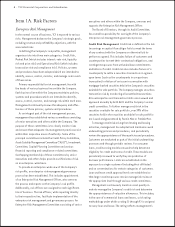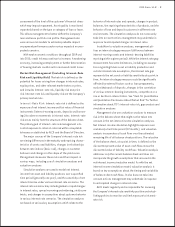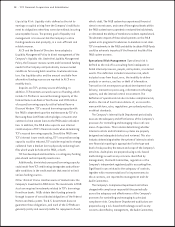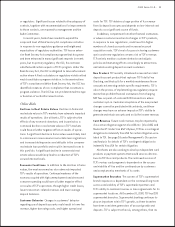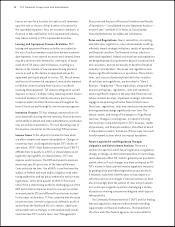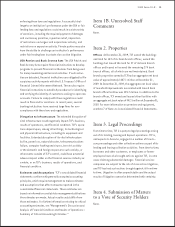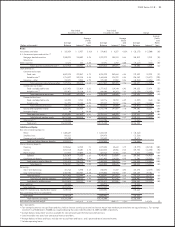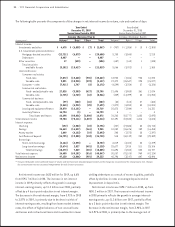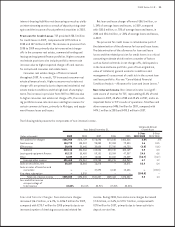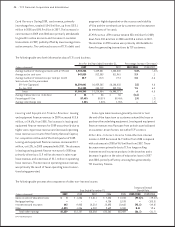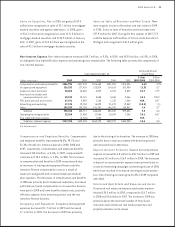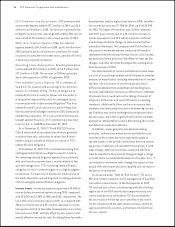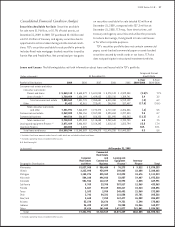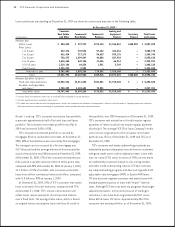TCF Bank 2009 Annual Report Download - page 34
Download and view the complete annual report
Please find page 34 of the 2009 TCF Bank annual report below. You can navigate through the pages in the report by either clicking on the pages listed below, or by using the keyword search tool below to find specific information within the annual report.
18 : TCF Financial Corporation and Subsidiaries
TCF’s lending strategy is to originate high credit quality,
primarily secured, loans and leases. TCF’s largest core
lending business is its consumer real estate loan operation,
which offers xed- and variable-rate loans and lines of
credit secured by residential real estate properties.
Commercial loans are generally made on local properties
or to local customers. The leasing and equipment nance
businesses consist of TCF Equipment Finance, a company
that delivers equipment nance solutions to businesses in
select markets, and Winthrop Resources, a company that
primarily leases technology and data processing equipment.
TCF’s leasing and equipment nance businesses have
equipment installations in all 50 states and, to a limited
extent, in foreign countries. In December 2008, TCF Inventory
Finance commenced lending operations to provide inventory
nancing to businesses in the United States and Canada.
Net interest income, the difference between interest
income earned on loans and leases, securities available
for sale, investments and other interest-earning assets
and interest paid on deposits and borrowings, represented
54.6% of TCF’s total revenue in 2009. Net interest income can
change signicantly from period to period based on general
levels of interest rates, customer prepayment patterns,
the mix of interest-earning assets and the mix of interest-
bearing and non-interest bearing deposits and borrowings.
TCF manages the risk of changes in interest rates on its net
interest income through an Asset/Liability Management
Committee and through related interest-rate risk monitor-
ing and management policies. See “Item 1A. Risk Factors”
and “Item 7A. Quantitative and Qualitative Disclosures
about Market Risk” for further discussion.
Non-interest income is a signicant source of revenue
for TCF and an important factor in TCF’s results of opera-
tions. Increasing fee and service charge revenue has been
challenging as a result of changing customer behavior.
Providing a wide range of retail banking services is an
integral component of TCF’s business philosophy and a
major strategy for generating additional non-interest
income. Key drivers of non-interest income are the number
of deposit accounts and related transaction activity. The
Federal Reserve issued a new regulation in November of
2009 that restricts the imposition of overdraft fees which
could have a signicant adverse impact on TCF’s non-inter-
est income. Starting on July 1, 2010, TCF will have to ask
their customers to opt in before TCF can assess fees for
ATM and debit card overdraft transactions.
Recent legislative proposals would, if enacted, further
restrict or limit TCF’s ability to impose overdraft fees on
retail checking accounts and interchange fees on debit card
transactions and could have a signicant adverse impact
on TCF’s non-interest income.
In response to these new regulations, TCF recently
introduced a new anchor checking account product that
will replace the TCF Totally Free Checking product. The new
product will carry a monthly maintenance fee on accounts not
meeting certain specic requirements. See “Management’s
Discussion and Analysis of Financial Condition and Results
of Operations — Consolidated Income Statement Analysis
— Non-Interest Income” and “Management’s Discussion and
Analysis of Financial Condition and Results of Operations
— Forward-Looking Information” for additional information.
The Company’s Visa debit card program has grown
signicantly since its inception in 1996. TCF is the 10th
largest issuer of Visa Classic debit cards in the United
States, based on sales volume for the three months ended
September 30, 2009, as published by Visa. TCF earns
interchange revenue from customer card transactions paid
primarily by merchants, not TCF’s customers. Card products
represent 23.3% of banking fee revenue for the year ended
December 31, 2009, and change based on customer pay-
ment trends and the number of deposit accounts using the
cards. Visa has signicant litigation against it regarding
interchange pricing and there is a risk this revenue could
be impacted by any settlement or adverse rulings in such
litigation. See “Item 1A. Risk Factors — Card Revenue” for
further discussion.
The following portions of Management’s Discussion and
Analysis of Financial Condition and Results of Operations
focus in more detail on the results of operations for 2009,
2008 and 2007 and on information about TCF’s balance
sheet, credit quality, liquidity, funding resources, capital
and other matters.
Results of Operations
TCF reported diluted earnings
per common share of $.54 for 2009, compared with $1.01
for 2008 and $2.09 for 2007. Net income was $87.1 million
for 2009, compared with $129 million for 2008 and $266.8


